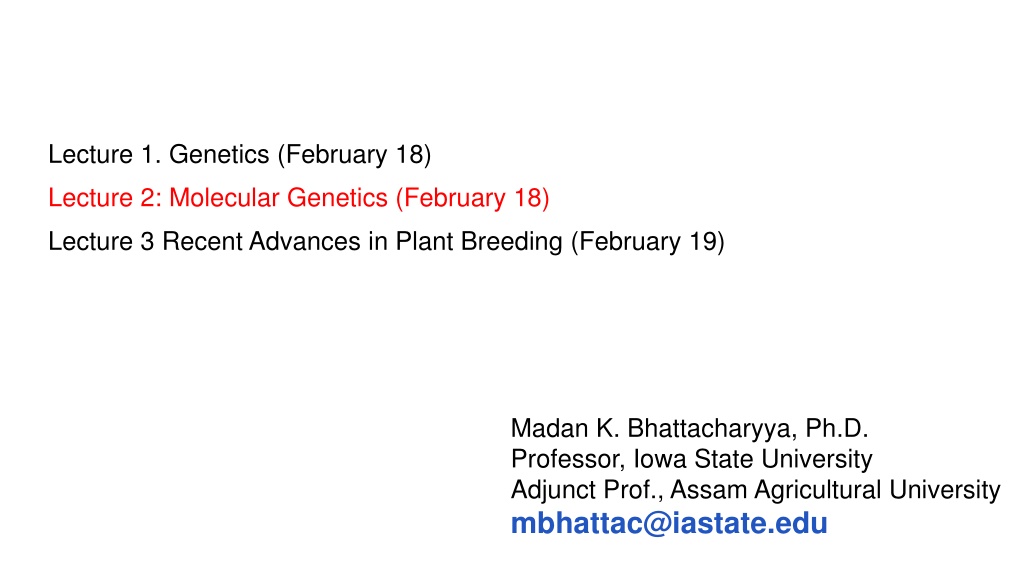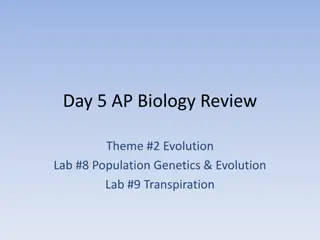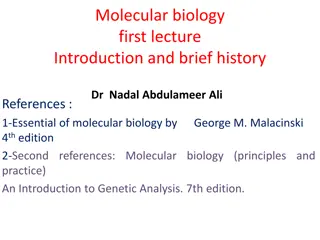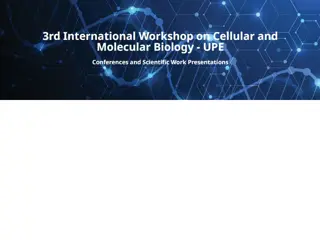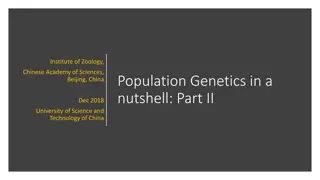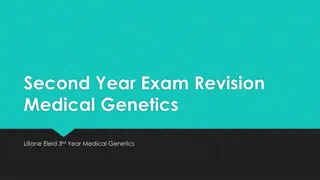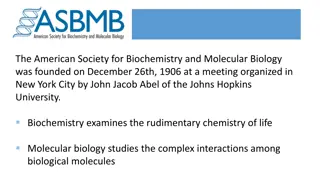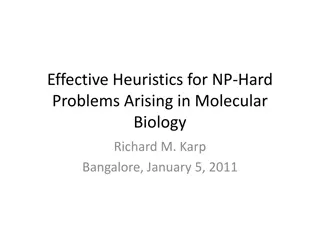Genetics and Molecular Biology Lecture Series by Dr. Madan K. Bhattacharyya
Explore a comprehensive lecture series covering Genetics, Molecular Genetics, and Recent Advances in Plant Breeding by expert Dr. Madan K. Bhattacharyya. Delve into topics such as gene structure, transcription, translation, and the central dogma of molecular biology through informative visuals and valuable insights. Access the website for related presentations and papers for further learning.
Download Presentation

Please find below an Image/Link to download the presentation.
The content on the website is provided AS IS for your information and personal use only. It may not be sold, licensed, or shared on other websites without obtaining consent from the author. Download presentation by click this link. If you encounter any issues during the download, it is possible that the publisher has removed the file from their server.
E N D
Presentation Transcript
Lecture 1. Genetics (February 18) Lecture 2: Molecular Genetics (February 18) Lecture 3 Recent Advances in Plant Breeding (February 19) Madan K. Bhattacharyya, Ph.D. Professor, Iowa State University Adjunct Prof., Assam Agricultural University mbhattac@iastate.edu
Website for the presentations and papers http://aau.ac.in/NAHEP/
Lecture 2 - Molecular Genetics 2 to 4 PM of February 18, 2020 Gene structure Transcription Translation Central dogma Metabolites and metabolic pathway Molecular basis of phenotypes
The central dogma of molecular biology is an explanation of the flow of genetic information within a biological system. Francis Crick (1958, 1970) The central dogma of molecular biology deals with the detailed residue-by-residue transfer of sequential information. It states that such information cannot be transferred from protein to either protein or nucleic acid. Francis Crick (1970)
The central dogma of molecular biology is an explanation of the flow of genetic information within a biological system. Jim Watson (1965) in the first edition of The Molecular Biology of the Gene described this simple version.
What is a gene? The first mention of gene was made by Mendel. He explained his results in terms of discrete inherited units (now known as genes) that give rise to observable physical characteristics. In 1905, Johannsen introduced the term 'gene' and in 1908, Bateson termed genetics. Today you have learned that a gene, a DNA segment, contains information for a protein that mediates gene-function. This is the central dogma of molecular biology "DNA makes RNA and RNA makes protein.
We now know much more than 1950s or 1960s! Is the central dogma still relevant?
Not really some of the exceptions are listed below: Same gene may have splice variants with distinct regulatory functions; e.g. tobacco N gene encoding TMV resistance Multiple subunits of an enzyme could be encoded by a number of genes. t-RNA genes for t-RNAs involved in protein synthesis. snRNA genes for snRNAs involved in splicing pre-mRNAs. Ribosomal genes for rRNAs involved in protein synthesis. Micro-RNAs with regulatory functions. Prions can make more prions from normal proteins.
Metabolites are closest to phenotypes Genes mRNAs Proteins Metabolites Phenotypes
Biosynthetic pathway of four major classes of anthocyanins Biosynthesis of the 4 major classes of anthocyanins (Grotewold, 2006). Names of compounds are indicated and enzymes, in black boxes, are as follows: CHS, chalcone synthase; CHI, chalcone isomerase; F3H, flavanone 3-hydroxylase; F3 H, flavanone 3 -hydroxylase; F3 ,5 H, flavanone 3 ,5 -hydroxylase; DFR, dihydroflavonol 4-reductase; LDOX/ANS, Grotewold E. 2006, Annu. Rev. Plant-Biol. 57:761-80. leucoanthocyanidin dioxygenase/anthocyanidin synthase.
Metabolites provide the petal color phenotypes. Flower displaying the three major types of pigments and the corresponding structures. (a) Portulaca (Portulaca grandiflora) flowers accumulating primarily the betalain pigment, betanin (R1 = R2 = H). (b) Marigold (Tagetes patula) flowers accumulating the carotenoid pigment, lutein. (c) Petunia (Petunia hybrida) flower accumulating an anthocyanidin, cyanidin. Grotewold E. 2006, Annu. Rev. Plant-Biol. 57:761-780
Wrinkled Pea Seed Variegated Soybean Flower
Starch Biosynthetic Pathway in r Pea Mutant 40% to 65% X 45% to 32%
The r pea mutant 10% from 6% in Sweet Peas
Starch Branching Enzyme I is Impaired in the r Pea Mutant 40% to 65% X 45% to 32%
A transposon-like insertion caused mutation in a starch branching enzyme gene located in the r locus studied by Gregor Mendel. DNA blot RNA blot Southern blot Northern blot Bhattacharyya et al. 1990
How does wrinkled seed phenotype develop in the sweet r mutant? Lack of SBEI Low Amylopectin and High Amylose Sugars Increased from ~ 6 to 10% Increased Osmotic Potential Higher Water Uptake During Seed Development Cell Shrinking During Seed Maturation Wrinkled Seeds Bhattacharyya et al. 1993
The W4 locus + p-Coumaroyl-CoA 3 x Malonyl-CoA CHS Chalcone CHI Naringenin Flavanone 3-hydroxylase(Wp) F3 5 H Dihydromyricetin Dihydrokaempferol F3 H Dihydroquercetin (Dihydroflavonols) Flavonol synthase Flavonol synthase Flavonol synthase (Wm) Kaempferol Myricetin Quercetin (Flavonols) Dihydroflavonol-4- reductase (DFR) (W3,W4) Dihydroflavonol-4- reductase (DFR) (W3) Dihydroflavonol-4- reductase (DFR) (W3, W4) Leucocyanidin Leucopelargonidin Leucodelphinidin Anthocyanidin synthase 3-glucosyl transferase (ANS) (Leucoflavonols) Anthocyanidin synthase 3-glucosyl transferase Anthocyanidin synthase 3-glucosyl transferase Cyanidin-3-glucoside Pelargonidin-3-glucoside Delphinidin-3-glucoside (Anthocyanins) Xu et al. 2010
A CACTA-type Transposable Element Tgm9 in the DFR2 Intron II causes loss of DFR2 function in Soybean. TATA box CTAAGGCGGTTATAAATAACCATCTTAGTAACTCGCTGGGTGGCATTTTT ATG TAA ATG TAA Tgm9 (20,548 bp) 4 1 2 3 10 5 6 8 9 11 12 14 18 20 7 13 15 16 17 19 21 22 23 24 25 26 27 ORF1 (GmTNP2) ORF2 (GmTNP1) Truncated Tgm9 (1354 bp) ATT Xu et al. 2010 Identical
The W4 locus + p-Coumaroyl-CoA 3 x Malonyl-CoA CHS Chalcone CHI Naringenin Flavanone 3-hydroxylase(Wp) F3 5 H Dihydromyricetin Dihydrokaempferol F3 H Dihydroquercetin (Dihydroflavonols) Flavonol synthase Flavonol synthase Flavonol synthase (Wm) Kaempferol Myricetin Quercetin (Flavonols) Dihydroflavonol-4- reductase (DFR) (W3,W4) Dihydroflavonol-4- reductase (DFR) (W3) Dihydroflavonol-4- reductase (DFR) (W3, W4) Leucocyanidin Leucopelargonidin Leucodelphinidin Anthocyanidin synthase 3-glucosyl transferase (ANS) (Leucoflavonols) Anthocyanidin synthase 3-glucosyl transferase Anthocyanidin synthase 3-glucosyl transferase Cyanidin-3-glucoside Pelargonidin-3-glucoside Delphinidin-3-glucoside (Anthocyanins) Xu et al. 2010
What have you learned today? With new knowledge about genes available, the central dogma became irrelevant. Despite the information flow from DNA to RNA and then RNA to protein is universal; there are many exceptions discovered in later years. Gene does not work alone. A gene is a team player; work in a group. As you have seen, mutation in a single gene can have profound effect on phenotype. Wrinkled seed shape and sweetness in sweet peas are the result of a mutation in a starch branching enzyme gene leading to reduced amylopectin and increased amylose as well as sucrose contents. Variegated flowers in soybean is induced by excision of Tgm9 from the DFR2 gene, a member of the group of genes that control the anthocyanin biosynthetic pathway.
Plant Breeding Implications Traits are governed by a large number of genes. Genes we target to breed in are usually regulatory genes that control the entire pathway. Disease resistance (R) genes are a good example. R genes are single genes; they however need a large number of genes to manifest the resistance. Two metabolic pathways shown here also show how structural genes are important in manifesting phenotypes. Mutants are the keys to studying the phenotypes. Metabolic markers are better predictors of phenotypes. Why not apply? Metabolite panels are used to check our health!
Lets talk about the things that you are not clear! Let s talk about the things that you are not clear!
